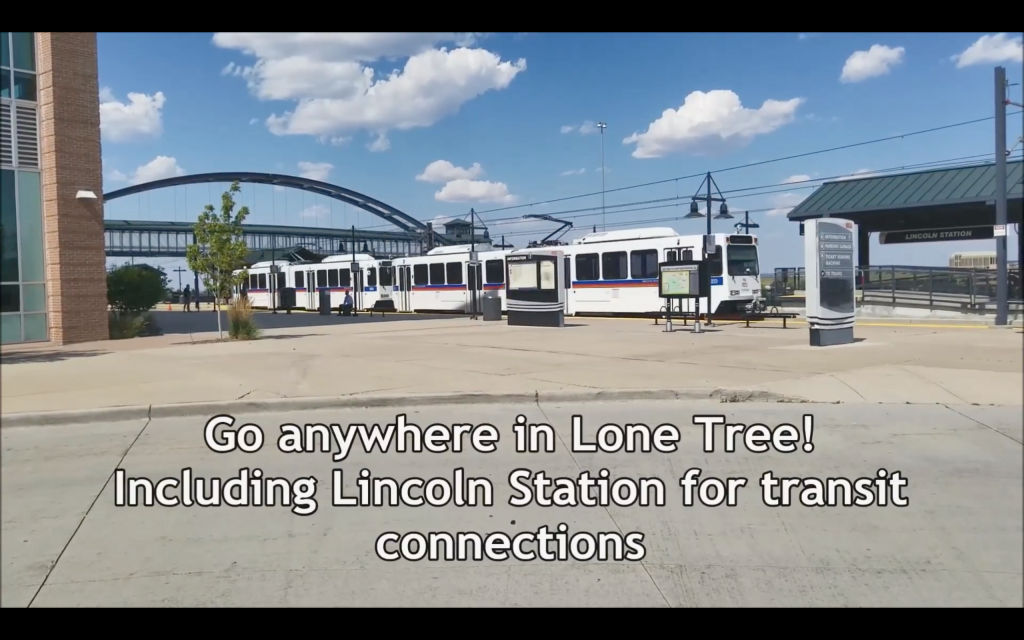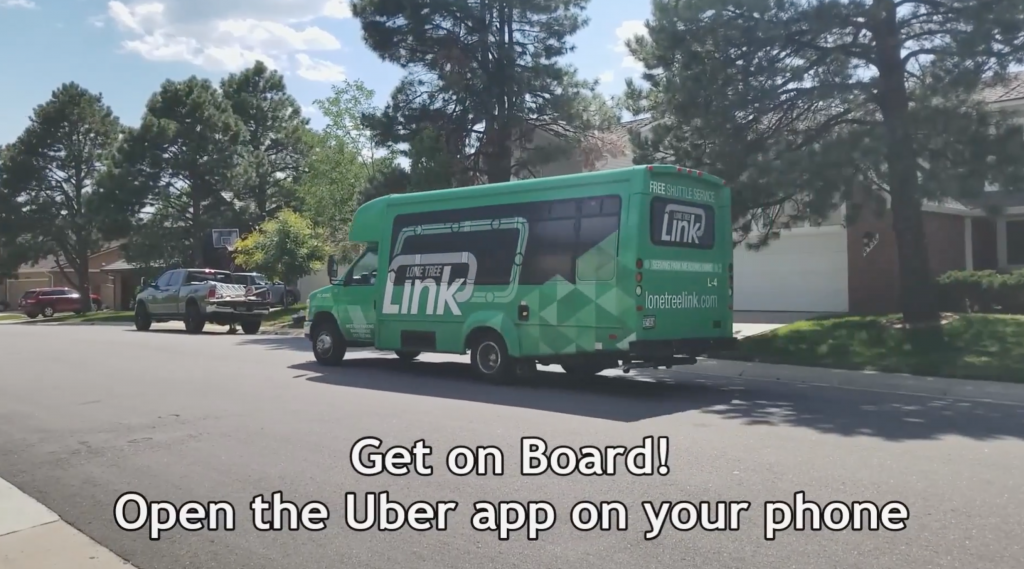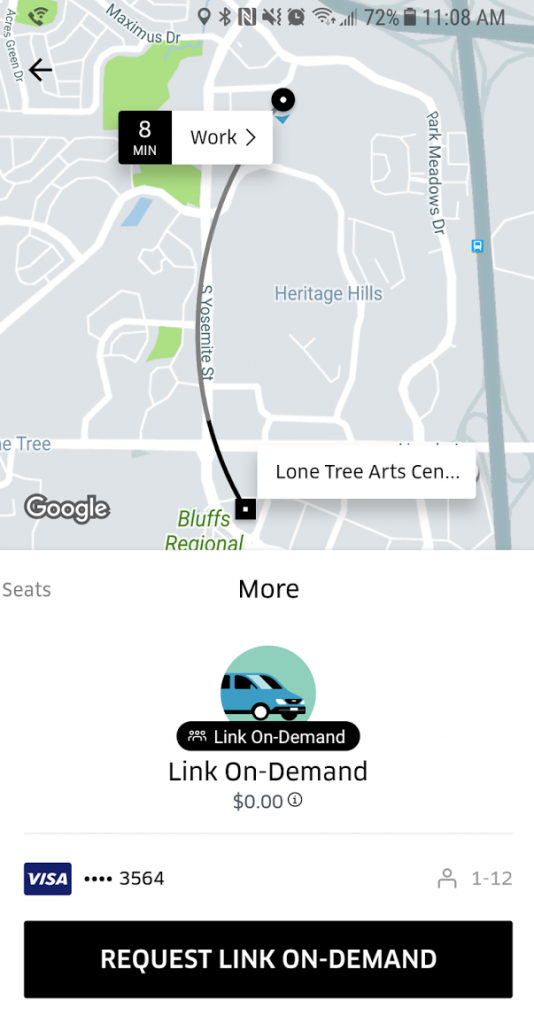Lone Tree, Colorado, one of the 16 members of our Smart Cities Collaborative, successfully launched a new pilot project last week. The small Denver suburb is evolving their existing fixed-route circulator served by four small buses by adding an on-demand component through a partnership with Uber.

For nearly three years, the city of Lone Tree southeast of Denver has been operating a fixed-route shuttle line every ten minutes on a loop that connects a Denver RTD light rail station with most of the city’s major employers. The Lone Tree Link has been funded through a unique public-private partnership that includes some of those employers. This helps cover the cost and provide the rides for free to customers, but running four buses on a predictable loop and maintaining ten-minute headways also limits the reach of the service.
In an evolution for the service, last week the city launched Lone Tree Link On Demand, which pairs Uber’s technology with the city’s vehicles and drivers to expand that service to more residents and increase accessibility. Now through the end of December anyone can use the Uber app to hail a Lone Tree Link shuttle for a free ride between any two points within the City of Lone Tree.

“We wanted to extend the reach of the successful circulator,” Seth Hoffman, the city manager of Lone Tree, told T4America last week. For the fixed-route service, “to get the headways we wanted to achieve, we had to keep the initial route narrow in scope. But that meant that it served employers but didn’t really serve retailers or residents. Putting it on demand makes it available to every address in the city.”
The genesis of Lone Tree’s partnership with Uber came about through the Smart Cities Collaborative.
“Our inclusion in the Smart Cities Collaborative got us in the door with Uber,” said Jeff Holwell, the economic development director of Lone Tree, referring to the ‘Industry Day’ portion of the Collaborative. “That connected us with Uber’s Denver office, which is what made this happen.”
“We were really floundering before that meeting,” Hoffman told us, but the connection with Uber at the Collaborative meeting helped them clear the final hurdle.
“Early on, we thought we’d find someone to help us develop our own app and start from scratch. But what we realized based on others’ experiences in the Collaborative, and through our contacts with T4A, was that smartphone real estate is really hard to compete with. If we could find someone that’s doing it and doing it well, that’s a quick path to our pilot.”
This partnership with Uber — which is as much a pilot for the private company as it is for the city — has simplified some of those tech issues. For example, as Holwell noted, adding one of the city’s extra shuttles to the service is “so easy with Uber’s technology — [the service] is as scalable as Uber is and they have incredible technology that we don’t have to create or update.”
The Denver Post covered the launch last week, and included a story that illustrates how the expanded service allows the city to connect residents and visitors to even more destinations in the city of about 10,000 people:
Divya Sheshathri and her friend Mugdha Maneesh used the service on Tuesday to get from Sheshathri’s home on Park Meadows Drive to her husband’s office on the Charles Schwab campus. They used it again to get from Schwab to Park Meadows mall for afternoon shopping. “It’s a very good service,” said Sheshathri, who does not own a car. “Without this it would be very hard to get around. We’re comfortable walking, but not in this hot sun.”
 For the pilot, Holwell said that they removed one of the four buses from the fixed route and reassigned it to the on-demand service, allowing the city to better calibrate their service with the need. And the returns have been positive thus far.
For the pilot, Holwell said that they removed one of the four buses from the fixed route and reassigned it to the on-demand service, allowing the city to better calibrate their service with the need. And the returns have been positive thus far.
“There was an immediate effect on day one,” Holwell said. “We’re already getting more ridership on that one vehicle than it was providing on the fixed route.”
While operating the fixed-route service is still their “bread and butter,” according to Holwell, with an additional RTD light rail station slated to open in 2019 just to the south that will replicate a portion of the fixed route service, shifting all of their resources to an on-demand service could be the roadmap for the future.
“We only operate during weekdays during office hours because it doesn’t make sense to run on weekends through empty office parks,” Holwell said. And even then, the fixed-route Link shuttles are obviously more heavily used at certain times like the start and end of the workday, leaving excess capacity during the day while they carry fewer passengers. With an entirely on-demand service, the city could better utilize their capacity and reduce empty miles traveled, which is one of their broader goals for the new on-demand service.
Lone Tree’s leaders are proactively using technology to become the kind of place they want to be long-term. And finding ways to better utilize their existing resources to serve residents, visitors and employers — whether transit vehicles or roadway space — is what this project is all about.
“Our big picture goal is to leverage the assets that we already have,” Hoffman said. “We can’t build additional lanes to fit more cars, so we’re going to try to use the lanes we have more efficiently. People are taking it to restaurants and taking it shopping, which helps out the local economy. As a medium dense suburban community, the density isn’t there in a way that would make a [larger] fixed route system work efficiently. This is a quicker way to deploy transit to our residents.”

Comments (1)
People need to exhibit more caution with Uber. They may be undermining themselves while considering themselves clever for doing so.